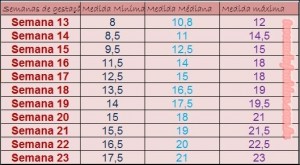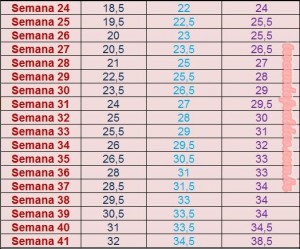The dream of every pregnant woman is to see her belly get bigger, growing every day. The larger the belly grows, it’s a clear sign the baby is also developing. As the baby grows, so does the uterus. So, during the prenatal appointment, besides listening to the baby’s heartbeat, the doctor also monitors the baby’s growth by measuring the uterine height. But do you know what uterine height is?
Why measure uterine height?
Uterine height is used to assess the baby’s growth inside the womb using a measuring tape. It is checked whether the growth is appropriate for gestational age1. The measurement is taken from the pelvis up to the top of the belly at that moment. Normally, gestational weeks are considered to correspond to the correct uterine height — they should be proportional to each other. That is, in the early stages of pregnancy, the uterine height should match the number of weeks of pregnancy. For example:
- 25 weeks pregnant = 25 cm UH
- 38 weeks pregnant = 34 cm UH
In the last weeks of pregnancy, however, the ideal is that the uterine height is at least 4 cm less than the number of gestational weeks. For example:
When to start measuring?
Uterine height starts being measured at around 16 weeks, or in some cases, at 20 weeks. That’s when the uterus begins to stand out from the pelvic bone, reaching the level of the navel. There are cases in which the uterine height differs from the number of pregnancy weeks.
There is a tolerance of 2cm above or below. However, uterine height outside this tolerance should be investigated to determine the causes. In both cases, whether the uterine height is greater or less, the doctor will request an ultrasound exam to confirm gestational age.
Uterine height below what’s indicated
Most cases in which uterine height is less than indicated for the gestational age may indicate a baby with restricted growth. SGA babies (small for gestational age) may be experiencing restricted weight gain. Common causes2 for placental insufficiency are high blood pressure and diabetes, which make it harder for the placenta to exchange nutrients with the baby.
After confirming gestational age — usually based on the first ultrasound and the most recent as well — the baby’s parents’ physical and biophysical aspects are taken into account. Shorter and slimmer parents tend to have smaller babies due to genetics. This can be surprising when measuring uterine height at the doctor’s office.
Women who go to the gym may also have a smaller than ideal uterine height. In these cases, however, the doctor will notice the abdominals are firmer. If everything is fine with the baby and placenta, the doctor will simply monitor the baby’s growth more closely. For this, a chart is used to track and compare uterine height measurements.
Reference chart for uterine growth during pregnancy
Click the images to enlarge
Uterine height greater than ideal
This can happen for several reasons, including a larger baby than expected, uterine fibroids, twin pregnancy, and even gestational diabetes. Most cases of greater uterine height are due to pregnancies with tall or heavier babies, but most of these are not a cause for concern3. However, it is important to check for conditions such as diabetes, which may require treatment.
The baby’s position inside the uterus can also influence a greater than expected uterine height for that gestational age. The placenta can also interfere with measuring uterine height.
As previously mentioned, an ultrasound can reveal the reason for a higher uterine height. Amniotic fluid volume is another factor — if it is low, it can cause uterine height to be lower than ideal. If it’s higher, it causes polyhydramnios, which can be easily seen in a routine ultrasound or if the doctor suspects it.
What does it mean when uterine height decreases?
As the baby’s birth approaches, the uterine height may also decrease. When the baby drops into the pelvis (engagement), the uterus automatically loses height. That is why a low belly in pregnancy means the baby is already engaged. Women with more than one pregnancy may also have uterine height greater than expected, but the doctor will know this from the early prenatal history.
Don’t be alarmed if the uterine height is different from what’s indicated. Always, in any situation, the doctor should and will certainly guide you on what to do and will know how to manage the situation. Always remember: make your obstetrician your best friend!
See also: Fetal Monitor – Listen to Your Baby’s Heartbeat at Home!













